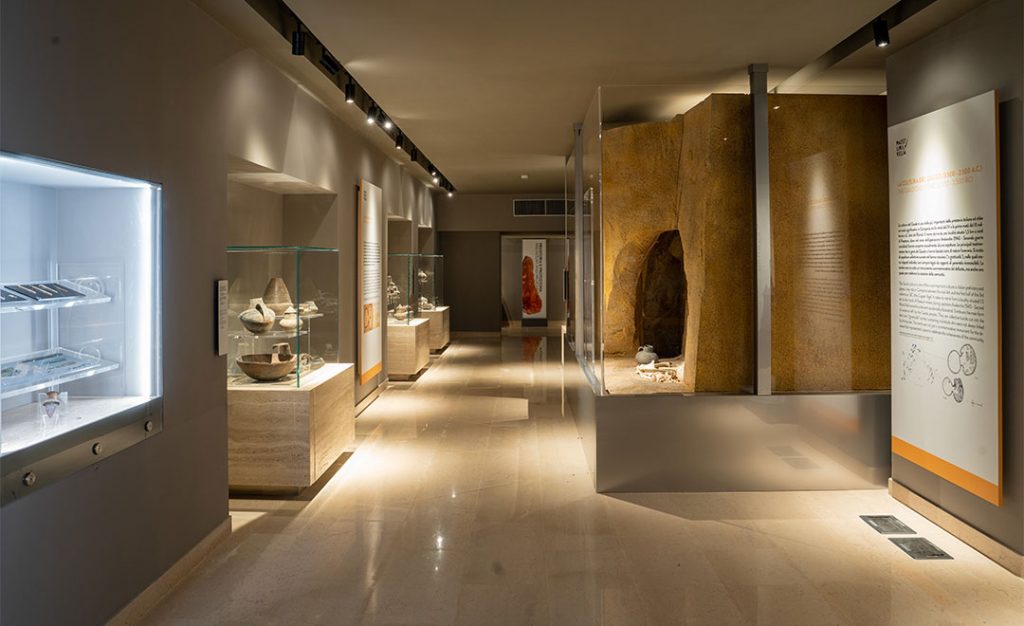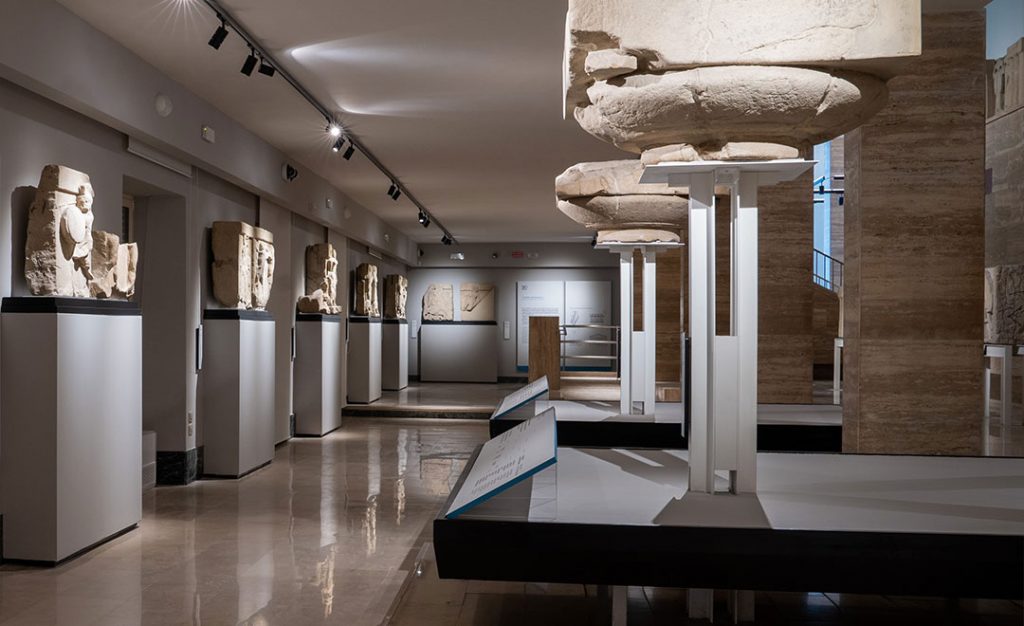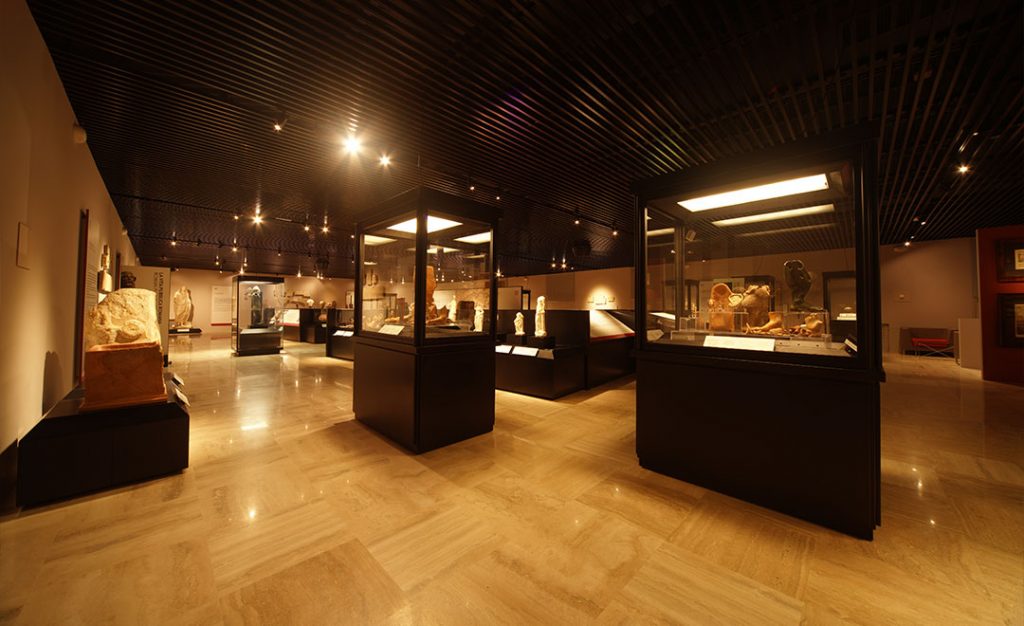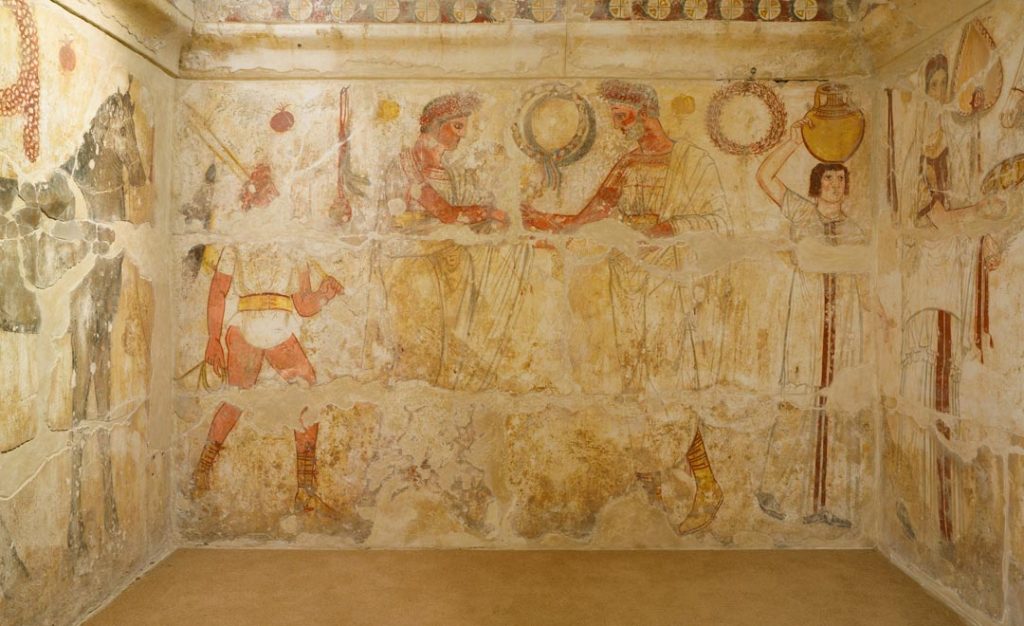The National Archaeological Museum of Paestum
The National Archaeological Museum of Paestum stands at the heart of the ancient city of Poseidonia–Paestum and has housed one of Italy’s most important archaeological collections since 1952. Since October 2023, the museum has welcomed you with a completely renewed and expanded layout, enriched with educational displays and multimedia content. It’s a museum designed for everyone—fully accessible and offering a wide range of engaging and inclusive experiences.
As you explore the galleries, storerooms, and archives, you’ll encounter an extraordinary number of artefacts and documents—the result of over a century of excavations and research. These collections trace the full history of Poseidonia–Paestum and the surrounding area: from the earliest evidence of human presence, around 40,000 years ago, through the Prehistoric and Protohistoric periods of the Sele plain, and on to the Graeco-Lucanian, Roman, Late Antique, Medieval, and modern eras. The museum also highlights the rediscovery of the site in the 18th century and the interest it sparked among scholars and Grand Tour travellers.
Among the museum’s most iconic works, you’ll find the extraordinary cycle of metopes—stone slabs carved with mythological scenes—that once adorned the temple of the sanctuary of Hera on the River Sele in the 6th century BC; the famous Tomb of the Diver from the 5th century BC; painted slabs from Lucanian tombs of the 5th–4th centuries BC; and the bronze statue of the silenus Marsyas, found in the Forum of the Roman city.
Behind the scenes, the museum’s laboratories, offices, library, and reading room are where the technical and scientific staff of the Parks work daily to care for the site’s cultural heritage. They collaborate with external scholars and professionals on research, conservation, restoration, and enhancement projects.
The museum is also a space for connection and creativity, where new social and cultural meanings take shape through a wide range of inclusive and participatory activities—educational workshops, temporary exhibitions, talks and conferences, as well as festivals celebrating art, science, music, theatre, and more.
Before you leave, don’t forget to visit the bookshop, where you’ll find printed guides and helpful resources for your visit, as well as both scientific and popular publications in Italian and major foreign languages—plus a variety of themed gifts and souvenirs.
The History of the Museum
The museum building is not just a space that holds artefacts, stories, and activities—it has its own story to tell, as a cultural property of notable historical and architectural significance.
It was designed in the 1930s by architect Marcello De Vita, on the initiative of the then-superintendent Amedeo Maiuri, to house the remarkable cycle of stone metopes carved with mythological scenes. These slabs were created around 570–560 BC to decorate a sacred building and were discovered during excavations in the sanctuary of Hera on the River Sele. Due to the outbreak of the Second World War, however, the museum was only completed and opened in 1952. The central section of the museum, built in a rationalist style, recalls the form of a temple. It features an internal chamber (cella), a three-step podium, and perimeter pillars evoking a colonnade. High on the exterior walls of the so-called “Cella Room”, the metopes were placed—where you can still see them today.
Over the years, the museum has been extended several times to accommodate the large number of finds brought to light through excavations and research in the city, its necropoleis, sanctuaries, and surrounding areas. The galleries have also been updated on several occasions to reflect new discoveries and evolving exhibition approaches. The first expansion began in 1959, with the construction of a new gallery to exhibit additional metopes and materials uncovered in the sanctuary of Hera on the Sele. A second phase of expansion started in 1968, adding a large wing at the rear of the museum dedicated to the urban sanctuaries, necropoleis, and painted tombs. A new room was also created for the celebrated Tomb of the Diver, discovered in 1968 by superintendent Mario Napoli. In 1972, in the museum’s courtyard and in an ideal dialogue with the tomb, a contemporary artwork by artist Carlo Alfano was installed. Part of the “Tempi Prospettici” series, it was the first contemporary art installation ever placed in an Italian archaeological museum. The work consists of a marble basin with flowing water and five cylinders made of different materials and varying heights. In more recent years, a third expansion added a gallery on the upper floor. Since 1999, this space has housed artefacts from the Roman period.
To meet the need for structural renovation and to bring the museum up to date with modern standards in education, communication, and accessibility, two major redevelopment projects were launched in 2019 and 2023. Funded by the PON “Culture and Development” FESR 2014–2020 programme, these projects aimed to rethink the museum in a way that better responds to contemporary needs. The structural and systems renovation was accompanied by a complete reorganisation of the archaeological collection, resulting in a newly designed visitor experience.
The Visitor Route at the National Archaeological Museum of Paestum
The museum’s new exhibition route is organised into sections that tell the story of the ancient city of Poseidonia–Paestum and the wider territory stretching from the River Sele in the north to the Agropoli promontory in the south, from the Palaeolithic period to the present day.
Original artefacts are displayed alongside educational panels and multimedia content, all developed in line with the latest standards in museum communication and accessibility. These resources allow you to explore the collection in greater depth and personalise your visit.
The layout is designed to echo the stratigraphic sequence of an archaeological excavation—moving from bottom to top, and from the oldest layers to the most recent.
Your visit begins in the basement level with the “Prehistory and Protohistory” section, which explores the earliest phases of human presence and settlement in the region.
You then continue on the ground floor and first floor with the section “The Graeco-Lucanian city”, dedicated to the history of Poseidonia during the Greek and Lucanian periods.
The second floor hosts the section “Paestum: from the Roman city to the present day”, which traces the changes that took place in Paestum during the Roman, Late Antique, Medieval, and modern eras—up to the site’s rediscovery in the 18th century and the latest developments in archaeological research.
Also accessible from the basement level is the new section “Beyond the Museum”, dedicated to the museum’s archaeological storerooms. These areas can be visited daily with museum staff.
On the ground floor, you’ll also find a dedicated space for small temporary exhibitions, where recent archaeological discoveries and ongoing research projects are presented.

Section “Prehistory and Protohistory”
Located on the basement level, the “Prehistory and Protohistory” section is dedicated to the memory of archaeologist Gianni Bailo Modesti, who curated its first layout in 2007.
Long before the foundation of the Greek city and its later Lucanian and Roman conquests, the area around Paestum was inhabited continuously for thousands of years. This section offers an overview of the earliest human presence in the region, spanning from around 40,000 years ago to approximately 600 BC—covering a vast period from the Palaeolithic to the Iron Age and beyond.
The first room focuses on the “Gaudo Culture”, which flourished during the Copper Age (c. 3,500–2,500 BC). Significant archaeological finds from this period were discovered by chance in the Gaudo area, about 1.5 km north of Paestum, during Operation Avalanche in the Second World War.
Large collective tombs were carved into the rock, such as the one reconstructed in the centre of the exhibition. These contained the remains of the deceased along with rich grave goods—handcrafted items of great variety and elegance, including flint and copper tools, weapons, and ceramic vases made from coarse clay. Among the most distinctive pieces are the “pyxides”, lidded vases with unusual shapes and decorative motifs that may have been inspired by models of ancient huts.
A long corridor continues the journey, tracing the development of settlement, craftsmanship, and funerary rituals in the region through the various phases of the Palaeolithic, Neolithic, Copper Age, Bronze Age, and Iron Age, leading up to the foundation of the Greek colony of Poseidonia. One particularly fascinating object is a small terracotta figurine known as the “Neolithic Venus” (c. 5,000–4,500 BC), with exaggerated hips—typically interpreted as a fertility symbol.

Section “The Graeco-Lucanian city”
The “Graeco-Lucanian city” section is the largest in the museum and it is located across the ground and first floors. It traces the long history of the city from the foundation of the Greek colony around 600 BC, through the Lucanian conquest in the second half of the 5th century BC, to the establishment of the Latin colony in 273 BC, bringing the ancient spaces of Poseidonia back to life.
On the ground floor, the gallery dedicated to “The sanctuaries – Architecture” focuses on the development of temple design and the Doric order. It features architectural and decorative elements in stone and painted terracotta from the sanctuary of Hera on the River Sele, as well as from the northern and southern urban sanctuaries of Paestum. This gallery also includes a historic museum display case, now updated, showing red-figure vases from both the Greek and Lucanian periods—imported from Athens or produced locally—depicting the gods and heroes once worshipped in the city.
Directly connected to this is the first-floor gallery dedicated to “The sanctuaries – Cults”. It explores the rituals performed in honour of the gods, both in the urban sanctuaries and in the sanctuary of Hera on the Sele. On display are votive offerings and other objects used in sacred ceremonies: figurines in stone and terracotta, painted ceramics, imported and local, weapons, jewellery and ornaments in metal, bone and ivory, a stone stele dedicated to the centaur Chiron, and an inscribed altar. The displays also present key deities such as Hera and Athena. A highlight of the new layout is a striking bronze bearded head found in the River Sele, possibly part of a life-sized statue of uncertain date.
On the ground floor, the “Cella” Room tells the story of the museum and houses painted slabs from a Lucanian tomb dating to the 4th century BC. These were recovered from illicit excavations and seized in the United States in 2022, before being returned to Paestum in 2023. From both the ground and first floors, visitors can view the famous cycle of archaic metopes from the sanctuary of Hera on the Sele, dating to around 570–560 BC. These remain in their original display on the outer walls of the “Cella” Room but have been reinterpreted within the new museum route. The space is also used for temporary exhibitions, talks, educational activities, and cultural events.
The large gallery known as “Public space” recreates a gathering area within the museum, inspired by the ancient agora—a square used during the Graeco-Lucanian period for political and commercial activities. A section is devoted to coinage, including its production and circulation in the city, accompanied by educational content that explores this central aspect of the ancient economy. The room evokes the agora through reconstructions and large-scale illustrations of its key buildings. These include the Heroon, a shrine to the city’s legendary founder, built around 510 BC, which yielded an exceptional group of grave goods including bronze vases, an Attic black-figure amphora, iron spits, and remains of an unidentified organic substance. The Ekklesiasterion, built around 480–470 BC, was the site of public assemblies and is especially noted for a famous Oscan-inscribed stele discovered there. The gallery also features tiered seating inspired by the original Ekklesiasterion, which today hosts audiences during cultural events.
The room dedicated to the “Tomb of the Diver” is named after archaeologist Mario Napoli, who discovered the tomb in 1968. This space displays the five painted slabs and the distinctive grave goods from this iconic Greek-era tomb, dated to around 470 BC. It remains a unique and much-studied work within the museum. In the courtyard just outside, in ideal dialogue with the tomb, stands a contemporary installation by Carlo Alfano from his series “Tempi Prospettici”. Installed in 1972, it was the first contemporary art piece placed in an Italian archaeological museum. It consists of a marble basin with flowing water and five cylinders of varying materials and heights.
The section also includes some galleries currently closed to the public, which will soon reopen with a completely renewed layout. “The Necropoleis” Room explores funerary practices and beliefs in the Greek and Lucanian periods, through grave goods recovered from the city’s main burial areas. These finds show how changing customs and rituals mark the shift from Greek traditions to Lucanian dominance. “The Territory” Room presents artefacts from the surrounding area, particularly from the sanctuaries that once formed a kind of sacred ring around the city. Finally, “The painted tombs” Room focuses on Lucanian funerary painting. It features numerous decorated slabs that illustrate the evolution of styles and iconography, as well as reconstructed tombs displayed as they were found during excavation, complete with associated grave goods.

Paestum: from the Roman city to the present day
Located on the second floor, the section Paestum: from the Roman city to the present day is dedicated to archaeologist Mario Torelli, who curated its original layout in 1999.
As you move through the gallery, you’ll follow Paestum’s history from the foundation of the Latin colony in 273 BC to the most recent archaeological finds from the modern era. A rich display of sculptures, inscriptions, coins, and everyday objects brings this long story to life. You’ll discover how religious practices evolved, how public and private spaces changed, and what daily life looked like—from coinage and rituals to art and architecture. The gallery presents both some of the museum’s most iconic pieces—like the bronze statue of the silenus Marsyas, found in the Roman Forum—and, for the first time, a selection of previously unseen finds uncovered in recent excavations or carefully chosen from the museum’s storerooms.
The final part of your visit is dedicated to the rediscovery of the site during the era of the European Grand Tour. Here, you’ll find a remarkable volume by Giovanni Battista and Francesco Piranesi with 18th-century engravings of the temples (1778), part of the museum’s collection, alongside ten evocative artworks from the Giambattista Vico Foundation, showing views of Paestum as seen by travellers and scholars of the 18th and 19th centuries. Original documents and photographs also take you through the beginnings of the major excavation campaigns, studies, and research efforts of the 20th century—work that continues to this day in the ongoing protection and enhancement of Paestum’s extraordinary archaeological heritage.

Section “Beyond the Museum” and Storerooms
Located on the basement level, the “Beyond the Museum“ section gives you access to the museum’s storerooms—an area of around 1,350 square metres that holds millions of archaeological finds. These objects come from years of excavations, chance discoveries, official seizures, and the recovery of artefacts from illegal digs. Since 2018, these spaces—once open only to specialists—have become a regular part of the museum experience. You can explore the storerooms every day by joining a themed guided tour.
Led by the museum’s staff, these visits take you behind the scenes to uncover little-known stories—some ancient, others surprisingly recent. You’ll get to know not just the objects themselves, but also the archaeologists, conservators, architects, and other professionals who care for them every day.
The tour begins with the “Tomb seized by the financial police”—a striking chamber tomb from the Spinazzo necropolis in Paestum, dating to the first half of the 3rd century BC. Its painted blocks were recovered in Taranto by the Guardia di Finanza (Italy’s financial and customs law enforcement agency) in 1976 and carefully reassembled at the museum. On the back wall, a moving scene shows a young man being welcomed into the afterlife by an elderly ancestor with a handshake. Around them, a procession unfolds across the side and entrance walls. The tomb dates to a time when ties between the Lucanians and Rome were strengthening, around the founding of the Latin colony at Paestum.
From there, the visit continues into the storage room that houses hundreds of painted slabs from the tombs of Paestum’s Lucanian elite—so significant that they form part of the museum’s core collection. These paintings once decorated the inner walls of tombs and were central to rich funerary rituals. Crafted by local artisans, the scenes feature colourful decorative patterns, plants, and vivid depictions of daily life and ceremony—designed to honour the deceased at the time of burial. The first discoveries of painted tombs in Paestum date back to the early 19th century, and new finds continue to emerge through systematic excavations and chance encounters.

The Tomb of the Diver
The Tomb of the Diver is the most iconic piece in the National Archaeological Museum of Paestum—unique in its kind and a defining part of the museum’s identity.
It is a truly extraordinary monument, the only known tomb from the 5th century BC in the Greek world decorated with figurative wall paintings. Discovered in 1968 in a small necropolis at Tempa del Prete, about 2 km south of the ancient city of Poseidonia-Paestum, the tomb dates to around 480–470 BC. The burial chamber was made of four large stone slabs forming the sides and a single cover slab, with the deceased laid to rest inside, accompanied by a set of grave goods.
The inner faces of the side walls and the lid were coated in white plaster and painted with vibrant scenes of great refinement and symbolic meaning. Along the walls, a symposium scene unfolds, rich with the pleasures of wine, music, and the game of kottabos. The lid features the tomb’s most famous image: a young man diving into a pool of water—an image that gives the tomb its name. According to the most widely accepted interpretation, the diving scene is symbolic rather than literal. It likely represents the passage from life to death—a metaphor for crossing into another realm. This imagery may reflect early mystery cult beliefs, which were beginning to spread at the time and offered the hope of life after death.
The objects buried with the deceased are just as remarkable: a lekythos (a vessel for perfumed oils) from Attic production, decorated with palmette motifs, and a lyre crafted from tortoiseshell, iron, and ivory. This lyre closely resembles those held by figures in the painted symposium scenes, linking the grave goods directly to the imagery on the walls.
Archaeological Diaries EP03 The Storerooms of the Paestum Museum
The third episode in the Archaeological Diaries series is dedicated to the storerooms of the National Archaeological Museum of Paestum.
This section of the museum, titled “Beyond the Museum”, offers a rare glimpse into spaces usually hidden from view. In this episode, Manuel Crisci—assistant for visitor services, reception, and security—guides you on a special tour into the heart of the museum, where the painted slabs from Lucanian tombs are carefully preserved.

I Parchi archeologici di Paestum e Velia sono un istituto del Ministero della Cultura dotato di autonomia speciale, iscritto dal 1998 nella lista del patrimonio mondiale UNESCO.
The Archaeological Parks of Paestum and Velia; an institute of the Ministry of Culture, with special autonomy and listed as a UNESCO World Heritage Site since 1998.